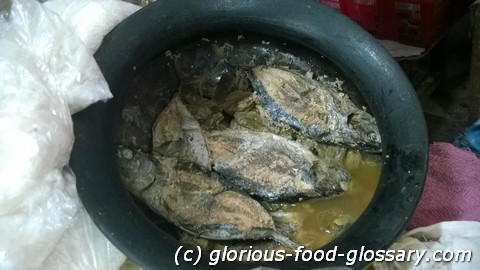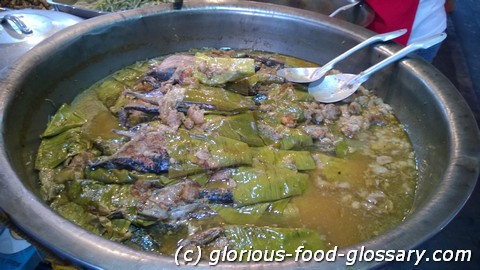Deutsch: Gekochter Tulingan / Español: Tulingan Cocido / Português: Tulingan Cozido / Français: Tulingan Cuit / Italiano: Tulingan Bollito
Sinaing na Tulingan is a traditional Filipino dish originating from the Batangas region, known for its method of slow-cooking Tulingan (bullet Tuna or frigate tuna) in a clay pot with water, salt, and sometimes, a variety of ingredients like dried kamias (bilimbi) or tamarind for added sourness. The dish is characterized by its simplicity, allowing the natural flavors of the fish to shine through, complemented by the tanginess of the souring agents and the depth of flavor achieved through the slow-cooking process.
Description
This method of cooking Tulingan involves cleaning the fish thoroughly, removing the innards and gills, and sometimes pressing salt into the flesh before wrapping it in banana leaves. The wrapped fish is then layered in a clay pot (palayok) with the souring agents and a small amount of water, and then simmered for several hours. This slow-cooking process not only tenderizes the fish but also infuses it with the flavors of the souring agents and banana leaves, resulting in a dish that is savory, slightly sour, and deeply aromatic.
Application Areas
Sinaing na Tulingan is a staple in Batangueño cuisine and has gained popularity across the Philippines for its distinct taste and the healthful way it's prepared. It's commonly served as a main dish with rice and can be found in local markets, fiestas, and traditional Filipino restaurants. The dish showcases the Filipino tradition of utilizing local ingredients and cooking techniques to create flavorful, satisfying meals.
Well-Known Examples
While Sinaing na Tulingan itself is a specific dish, the technique of sinaing, or slow-cooking in a palayok, is applied to other types of fish and meat within Filipino cuisine, demonstrating the versatility and depth of traditional cooking methods in the Philippines.
Treatment and Risks
The preparation of Sinaing na Tulingan requires attention to detail, particularly in cleaning the fish, to avoid any health risks associated with consuming improperly cleaned seafood. Additionally, the slow-cooking process ensures that the fish is cooked thoroughly, making it safe and enjoyable to eat. However, individuals with dietary restrictions related to sodium intake should consume this dish in moderation due to its salt content.
Summary
Sinaing na Tulingan is a beloved Filipino dish that exemplifies the richness of the country's culinary heritage, combining simple ingredients with time-honored cooking techniques to create flavors that are both complex and comforting. It stands as a testament to the Philippines' ability to transform everyday ingredients into extraordinary meals.
--


Related Articles to the term 'Sinaing na Tulingan' | |
| 'Sinigang na Baboy' | ■■■■■■■■■■ |
| Sinigang na Baboy is a classic Filipino dish known for its sour and savory flavors, primarily featuring . . . Read More | |
| 'Halabos na Hipon' | ■■■■■■■■ |
| Halabos na Hipon in the food context refers to a traditional Filipino method of cooking shrimp, where . . . Read More | |
| 'Paksiw na Bangus' | ■■■■■■■■ |
| Paksiw na Bangus in the food context refers to a traditional Filipino dish made with bangus (milkfish), . . . Read More | |
| 'Kamias' | ■■■■■■■ |
| Kamias is a Filipino fruit with scientific name Averrhoa bilimbi. The fruit is green and edible, about . . . Read More | |
| 'Batuan' | ■■■■■■■ |
| Batuan is a tropical fruit primarily used as a souring agent in Filipino cuisine. This small, green fruit . . . Read More | |
| 'Daing na Bangus' | ■■■■■■■ |
| Daing na Bangus in the food context refers to a traditional Filipino dish made from milkfish (Bangus) . . . Read More | |
| 'Nilagang Buto ng Baka' | ■■■■■■■ |
| Nilagang Buto ng Baka in the food context refers to a traditional Filipino soup made by slowly boiling . . . Read More | |
| 'Pinais na Isda' | ■■■■■■■ |
| Pinais na Isda is a traditional Filipino dish that involves wrapping fish or shrimp in banana leaves . . . Read More | |
| 'Kilawin' | ■■■■■■■ |
| Kilawin refers to a traditional Filipino dish similar to ceviche, involving raw seafood or sometimes . . . Read More | |
| 'Ilokano' | ■■■■■■■ |
| Ilokano refers to both a group of people and a language in the northern Philippines. In the context of . . . Read More | |
